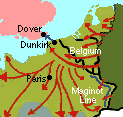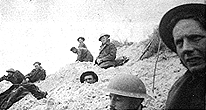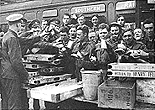|
Places to visit | Background information | Find a book about it |
|
|
|
1940:
Dunkirk evacuation, |
||
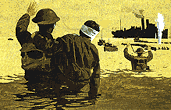 Soldiers wading out towards naval ships |
Nazi Germany invades
France May 1940 As defences collapsed and the Germans swept towards key targets like Paris and the Channel ports, hundreds of thousands of defeated British and French troops were surrounded in an "island" of not-yet-conquered territory around Dunkerque. |
|
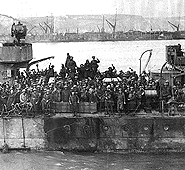 ..Troops cheer with relief when they arrive in Dover harbour after the perilous Channel crossing, where they faced attacks by German planes, E-boats and mines. It was standing room only for all but the wounded. |
|
MAP: showing Nazi German invasion of France through southern Belgium, by-passing France's elaborate fixed defences, the "Maginot Line". |
|
Evacuation - "miracle" of
Dunkirk Whatever the reason, this gave a window of opportunity to save as many as possible of the Allied troops to fight on another day - though all their equipment and weapons had to be left behind. Navy ships were hastily gathered and sent to the port of Dunkerque. Troops waited their turn to be evacuated on the surrounding sandy beaches. As the port, ships and beaches came under increasing aerial attack, civian small boats were requisitioned and sent across to help take men directly off the beaches. |
||
|
|
||
 MAP 2: 1940 Nazi Germany used the newly-conquered lands as a platform for air attacks in the Battle of Britain |
Operation
Sealion Meanwhile the Army prepared for "Operation Sealion" - the invasion of Britain. They collected thousands of barges in Calais and Boulogneharbours, and up the canals and rivers of Nord-Pas-de-Calais and Belgium, ready to carry the German army and its fearsome armour across the Channel to invade Britain. The Battle of Britain German bombers needed
fighter-escorts So long as the RAF had fighters to attack them, each lightly-armed bomber needed 2 fighters to escort it over England. Since they had only 700 fighters (slightly more than the RAF) this limited the number of bombers that could b sent in any one raid. Also the German fighters had a short range - even from bases near the coast in Nord-Pas-de-Calais, they could on;y provide max. 20 minutes protective cover over Kent, reaching just about as far as London . The bombers came from safer bases away from the coast. Whilst they had the flying range to penetrate further into Britain, they soon discovered that, without fighter escorts, they were too vulnerable. |
|
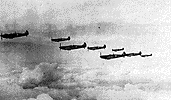 British fighters only fought over Kent, guided by radar to meet the German bombers. |
||
|
Failure of the invasion
plan But on 7th September, they switched tactics and started bombing London in massive daylight raids - believing perhaps that British resistance would crumble, and that the RAF would be forced to use its remaining reserve squadrons. But once the RAF had made its Kent airfields operational again, the German losses mounted. The Luftwaffe was clearly not invincible, and on 17th September, Hitler postponed the invasion "until further notice". |
||
 |
|
|
A group of museums and
historic sites have joined together to offer you a special
rate if you join their Association, and show your card on
entry. These are: |
|
|
||||
|
Other
Places to visit: |
|||||
|
Related background
information |
|
|
|
|
|

